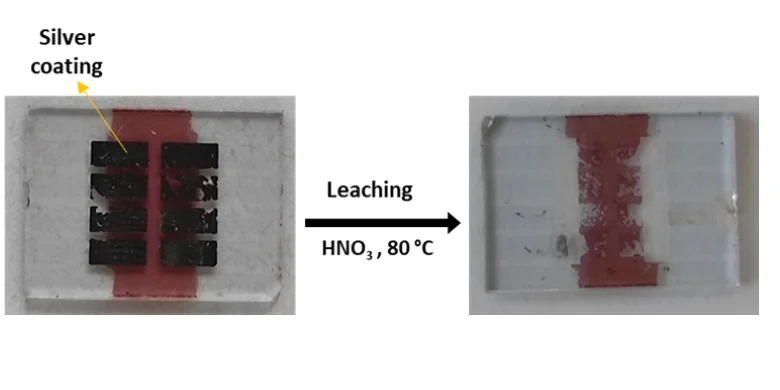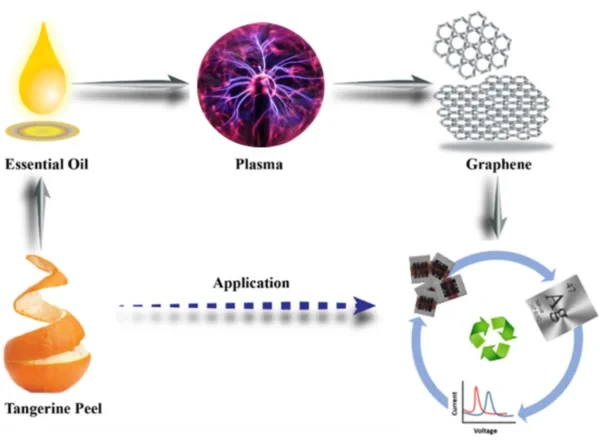Researchers at James Cook University have developed a process to synthesize graphene from tangerine peel oil, which they then used to recover silver from waste PV material. To demonstrate the quality of the recovered silver and the synthesized graphene, they made a dopamine sensor that reportedly outperformed reference devices.

A team from Australia’s James Cook University has synthesized “freestanding” graphene using non-toxic and renewable tangerine peel oil that can reportedly be used for the recovery of silver from end-of-life organic PV devices.
“Not only did it result in high-quality graphene, but it also demonstrated a remarkable ability to selectively recover silver from photovoltaic waste. One of the most surprising findings was how exceptionally selective the graphene was in targeting silver,” corresponding author Mohan Jacob told pv magazine.
The quality of both the recovered and synthesized materials was then demonstrated in a silver-enhanced SPE dopamine sensor device, which outperformed two reference dopamine sensors made without the silver graphene composite
Graphene synthesis
The team began the research by synthesizing graphene “using downstream microwave plasma” in atmospheric conditions. “The primary components of the system include a 2.45 GHz microwave generator, a matching network, a cooling system, and a reaction chamber,” it stated.
A Raman spectrum analysis of the graphene showed “a characteristic 2D peak” at microwave powers between 200 W and 1000 W. “The images of transmission electron microscopy revealed interstitial spacing of 0.34, which matched the value of X-ray diffraction calculated through Bragg’s law,” said the team.
Silver recovery from PV
The team then recovered silver from organic PV devices via leaching in a nitric acid solution. The PV coating contained indium tin oxide (ITO), zinc oxide (ZnO), molybdenum oxide (MoO3), and silver (Ag).
After the leaching was complete, the solution was cooled and used as a stock solution to create a graphene-coated SPE. “Following 10 min of electrodeposition, the Ag concentration slightly decreased to 1.69 ppm. This decrease suggests that some Ag ions were being reduced and deposited onto the electrode surface during the electrochemical process. After 20 min of electrodeposition, the Ag ions concentration further decreased to 1.62 ppm, indicating a continuous reduction in the Ag ion concentration,” said the academics.
“These results suggest that a longer duration of electrodeposition may lead to further reduction in the silver concentration.” The Ag deposition was confirmed with cyclic voltammetric detection.
“Despite the presence of various other compounds in the PV waste solution, the graphene exhibited an extraordinary ability to isolate and recover silver with high precision. This dual benefit of producing valuable graphene while selectively recovering silver from a complex mixture was an exciting and somewhat unexpected outcome,” said Mohan.
The team stated that the study “highlights the remarkable effectiveness” of graphene in recovering valuable metals like silver from e-waste.
“We chose to demonstrate with waste PV material because photovoltaic waste is a rapidly growing concern due to the increasing adoption of solar energy. The disposal of PV panels, which contain valuable metals like silver, poses both environmental and economic challenges. By focusing on PV waste, we aimed to develop a sustainable solution that addresses the urgent need for effective recycling methods while recovering valuable resources,” said Jacob.
Dopamine sensor demonstration
To illustrate the quality of the composite material in a real-world application, the team made a graphene-silver electrode (SPE/graphene-Ag) detector and compared it to a bare SPE detector and a graphene/SPE detector. Test results showed that the SPE/graphene-Ag electrode displayed “significant improvement in peak current” compared to the other two specimens.
Other applications of graphene-silver composites were suggested by the researchers, such as corrosion-resistant coatings, conductive inks to use flexible devices in the electronics industry, antimicrobial coatings for use in biomedical industries, as well as sensors to detect gases, biomolecules, and pollutants.
Their work is detailed in the paper “Green synthesis of graphene for targeted recovery of silver from photovoltaic waste,” published in Chemosphere.
The response to the research to date has been positive. “Our work has just come online, and we are overwhelmed by the response from our peers and their interest in our research,” said Jacob, adding that the group has received encouraging feedback about the “broader applicability and potential impact” of the work in the fields of battery and electronics waste.
The next steps for the team are to optimize the green synthesis process to improve its scalability and economic viability, aiming for a process that can be integrated into existing PV recycling and e-waste infrastructure. “We are actively looking at commercialization to bring these advancements to market and make a significant impact on the industry,” said Jacob. “We are also exploring partnerships with industry stakeholders and investors to pilot larger-scale implementations.”

This content is protected by copyright and may not be reused. If you want to cooperate with us and would like to reuse some of our content, please contact: editors@pv-magazine.com.
Source from pv magazine
Disclaimer: The information set forth above is provided by pv-magazine.com independently of Alibaba.com. Alibaba.com makes no representation and warranties as to the quality and reliability of the seller and products. Alibaba.com expressly disclaims any liability for breaches pertaining to the copyright of content.



